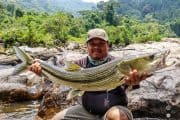
There are several Mahseer species in almost all of the Salween River tributaries of Mae Hong Son Province. However, even locally there is some confusion as to which is which! There is erroneous photographic identification across several Thai fishing websites. Even authoritative websites are sometimes in conflict. At least everyone agrees that there are multiple species…
There is general agreement on identity for Thai / Malayan Mahseer (Tor tambroides). Also on Blue Mahseer (Neolissochilus stracheyi) as they are quite distinctive. Some others, such Cave Mahseer, are easily identified due to the much larger eyes and preferred habitat along undercut banks and large rocks.
Where it becomes very difficult is the Golden / Himalayan Mahseer (Tor putitora) which may or not be the same thing. Identification may be compounded by subtle colour variations due to habitat (river bottom colouration). Also by changes in appearance during the transition from juvenile to mature fish.
- The taxonomy of the mahseers is confusing due to the morphological variations they exhibit. *Wikipedia: https://en.wikipedia.org/wiki/Mahseer
- The shape, size and length of the median lobe, the features that have often been used to distinguish species of Tor are highly variable. They are also influenced by environmental factors. This leads to confusion and as such its reliability as an indicator of species is questionable. * http://www.mahseertrust.org/downloads/Scientific_Publications/Nguyen%202008.pdf
Mahseer species distribution is throughout the Himalayan ranges that extend across much of S.E. Asia:. Myanmar and Thailand. Found in the Cardamon Range, Cambodia and in Laos, Malaysia and parts of Indonesia. Known to be present in catchments of the Salween, Mae Klong, Chao Phraya, Mekong, peninsular & southeast Thailand river systems.
Thai / Malayan Mahseer (Tor tambroides)
Thai Mahseer are found in clear, cold freestone rivers in the heavily forested mountain valleys of Mae Hong Son Province in north-west Thailand. Some rivers have sections holding high stocks of these fish.
Adults inhabit pools and runs over gravel and cobble in rivers flowing through undisturbed forests. Juveniles were most commonly collected in or near rapids. Found in small rivers and streams during the dry season. Move downstream at the onset of the rainy season, but generally avoid turbid waters. Mature individuals migrate upstream after two months and spawn in July near the mouths of small streams that the young subsequently ascend. Omnivorous, feeding on both animal and vegetable matter, at times consuming toxic fruits in flooded forests, making them temporarily inedible. Source: Fishbase.org
Blue Mahseer (Neolissochilus stracheyi)
Blue Mahseer are often found in the same locations as Thai & Golden Mahseer. Blue Mahseer prefer to inhabit clear swift flowing streams and rivers in forested areas. They are reputed to disappears when human activities degrade their aquatic habitats, this is also observed in other members of the genus. (Source: Fishbase.org) The very presence of Mahseer species is thus an indicator of water quality and environmental health in regions they inhabit.
Golden / Himalayan Mahseer (Tor putitora)
This fish is definitely not a Thai or Blue Mahseer – but is it the Golden Mahseer?
The Golden Mahseer was the fish that inspired Rudyard Kipling – his famous quote in reference to the Golden Mahseer in India (also found in Mae Sariang rivers) was “There he stood, the Mahseer of the Poonch, beside whom the Tarpon is a Herring and he who catches him can say he is a fisherman.”
In this next illustration, we have a juvenile version of the same species.
The morphological differences we see between photographs of our local Golden Mahseer and those of fish caught in India may have two simple explanations – environment and diet;
- Environment: India’s glacier-fed rivers with clean gravel bottoms induce lighter and brighter colouration, whereas local rain-forest rivers rich with algae and mosses induce darker colouration.
- Diet: India’s glacier-fed rivers have less biomass and far bigger & faster water flows, meaning fish must work harder to survive. Our local fish live in smaller, slower rivers with significant year-round food resources and thus have a higher food intake and are fatter by comparison.
Golden Mahseer can get big, fat and lazy here…





















